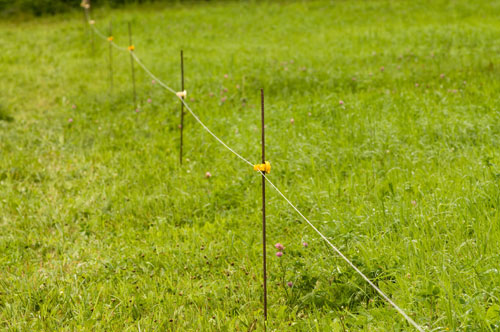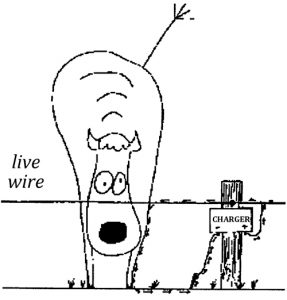Electric Fence Design
(Lesson 3. Fencing Systems continued)
 The effectiveness of any electric fence, whether it’s a one wire fence subdividing a pasture or a 9 wire fence protecting stock from predators, depends on the ability of the fence to deliver an unpleasant shock to animals that touch it. The ability of a fence to deliver that shock depends on three things:
The effectiveness of any electric fence, whether it’s a one wire fence subdividing a pasture or a 9 wire fence protecting stock from predators, depends on the ability of the fence to deliver an unpleasant shock to animals that touch it. The ability of a fence to deliver that shock depends on three things:
- the energizer
- grounding
- the fence design
The ideal fence is inexpensive to build and effectively control animals. There is no single design that meets these criteria for every application. The effectiveness of any design depends on the type of animal that must be controlled, the materials used in construction and site characteristics (e.g. soil moisture, terrain, etc.)
How Many Joules Do You Need?
The number of joules (unit of energy measurement) needed depends on the length of the fence, the number of electrified wires and severity of conditions. Joule recommendations of chargers are dependent on length of fence to charge and soil conditions on which you plan to erect a fence. If you wish to install and electric fence that is one mile in perimeter, and you are charging four strands on the fence, your total fence length is four miles. Check with your fencing supplier to determine the appropriate charger for your fencing needs. Under severe conditions (wire passing through heavy vegetation) higher joule ratings may be required.
Pulses
Energizers differ in the size and duration of the pulses of electrons they send into the fence line. A good energizer has an intense pulse lasting for 0.0003 seconds. These short pulses eliminate the risk of fire (the pulse is so short that no heat builds up in the wire). Poorer quality energizers have pulse lengths of 0.003 to 0.3 seconds. This longer “on” time may allow sparks to arc and heat to build up. This can cause fires. This will also shorten the life of polywire. (These long pulses will cause polywire to melt where it comes in contact with grass.)
High Impedance vs. Low Impedance
Impedance means leakage. Generally speaking, high voltage energizers with long pulses are high impedance energizers. The current leaks readily. Low impedance energizers resist leakage.
Power Source
If mainline power is available and dependable, 110 or 220 volt AC (plug it in the wall socket) energizers are usually most practical for permanent fences. Will they raise your electricity bill? Well, depending on the size of the unit, they typically draw 2 to 25 watts a day. The operational cost of an energizer drawing 17 watts a day would be about $1.50/month (assuming an electrical rate of $0.12/kilowatt hour).
AC chargers have several advantages over DC (battery powered) energizers:
- They require no battery maintenance
- They usually have higher joule ratings per dollar spent
- They are generally placed in or close to buildings (reducing the risk of vandalism)
Where mainline power is unavailable or unreliable, battery powered energizers are a practical alternative. Dry cell batteries can power some portable DC energizers. Beware — manufacturer estimates of battery life are usually optimistic. In permanent installations, solar is expensive but in the long run a viable alternative to constantly changing batteries.
For longer or permanent fences or for short temporary fences passing through tall wet grass (high leakage), larger energizers powered by 12-volt rechargeable wet cell batteries should be used. Deep cycle batteries are the batteries of choice. They can be completely discharged and recharged repeatedly. Conventional car batteries can be used but they are not designed to be totally discharged. They will only recharge up to about 60 to 75% of their original capacity.
Six Tips for Buying an Energizer
- Check the joule rating. Remember: you double the shock by doubling the joules.
- Buy an energizer with the capacity to do the job.
- Check the cost per joule. One way to compare the value of energizers is to calculate the cost per joule. Generally speaking, the lower the cost per joule the better the value.
- Buy a low impedance energizer with pulses of 0.0003 seconds or less.
- Look for solid state circuitry with modular service boards. It makes repair much faster and simpler.
- Check the guarantee. They vary in length and items covered. Some cover lightning damage.
Energizer Don’ts
- Don’t buy on price alone. The energizer with the cheapest price generally turns out to be the most expensive.
- Don’t skimp on the joule rating. Buying more joule capacity than currently needed will give you the flexibility to charge fences built in the future without having to buy an additional unit.
- Don’t forget to ground the system. Even the largest energizer in the world is useless without effective grounding.
Grounding Electric Fences
Poor grounding is the leading cause of electric fence problems. Eighty percent of electric fence problems can be traced to faulty grounding systems.
Effective grounding completes the circuit.
For an animal to receive a shock it must complete a circuit. The circuit can be either from the energizer through a “live” wire through the animal, through the soil, and through ground rods back to the energizer (figure 1A), or from the energizer, through a live wire, through the animal, through a ground wire back to the energizer (figure 1B).
Moist soil is a good conductor of electricity. However, when soil moisture is depleted (or not effective when frozen), animals will not be shocked by electric fences unless ground wires are included on the fence.
- Figure 1A. Soil Ground Return
- Figure 1B. Wire Ground return
Designing an Effective Grounding System
The grounding system for an electric fence is a little like a radio antenna. With a radio, the bigger the antenna, the better the reception. Likewise, your electric fence energizer requires a large grounding system to collect enough electrons from the soil to complete a powerful circuit.
A minimum of three ground rods should be used for each (most) energizer(s). Many 1 joule units only need 1 rod. Five-eighths inch diameter galvanized steel rods or 3/4″ galvanized pipe make the best ground rods (DO NOT USE COPPER). They should be at least 6 feet long and driven 5-1/2 feet into the soil. They should be spaced at least ten feet apart. More ground rods may be needed in dry areas. If your fence includes ground wires, it is advisable to install additional ground rods connected to the ground wire at 1500 foot intervals along the fence line (3000 foot intervals are adequate where soil is moist year round). Energizers should be connected to ground rods with 12-1/2 gauge wire attached with ground rod clamps (below). The connecting wire should be insulated so that it does not come in direct contact with the soil (i.e. 12-1/2 gauge direct burial cable is ideal). Use one continuous wire to connect all ground rods.

Lightning Protection
In addition to setting up the power system to the fence, one should consider and plan for a way to handle a lightning strike. If at all possible, the energizer should be unplugged during an electrical storm. Additionally, a lightning diverter (as good as or better than your grounding system) should be incorporated into your fencing construction. Check with your local fence dealer for information on lightning diverters.


